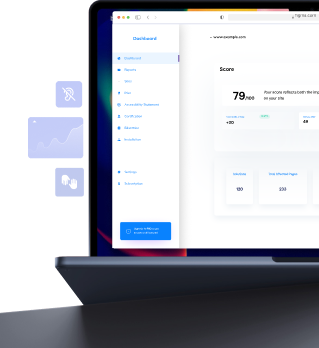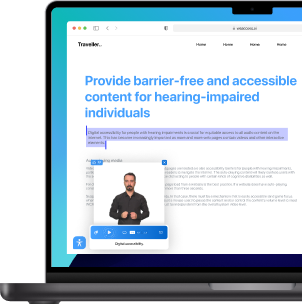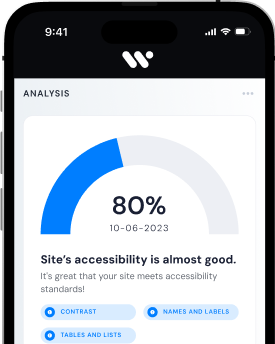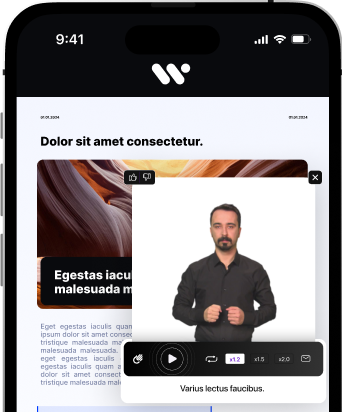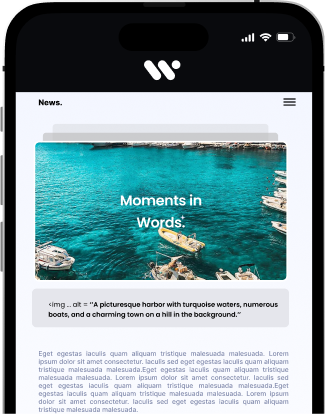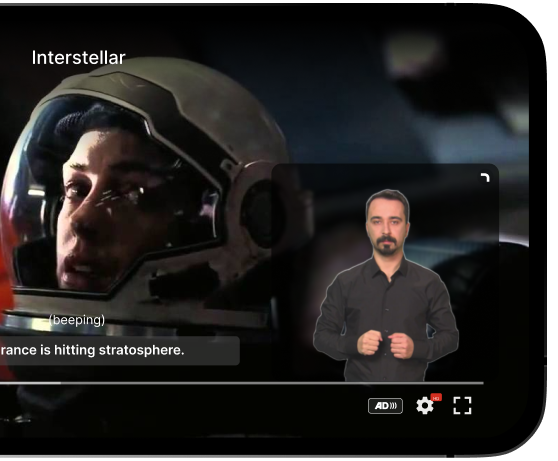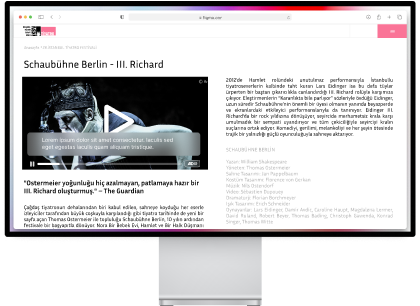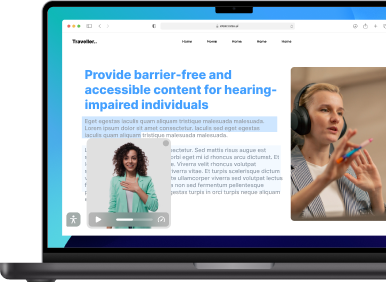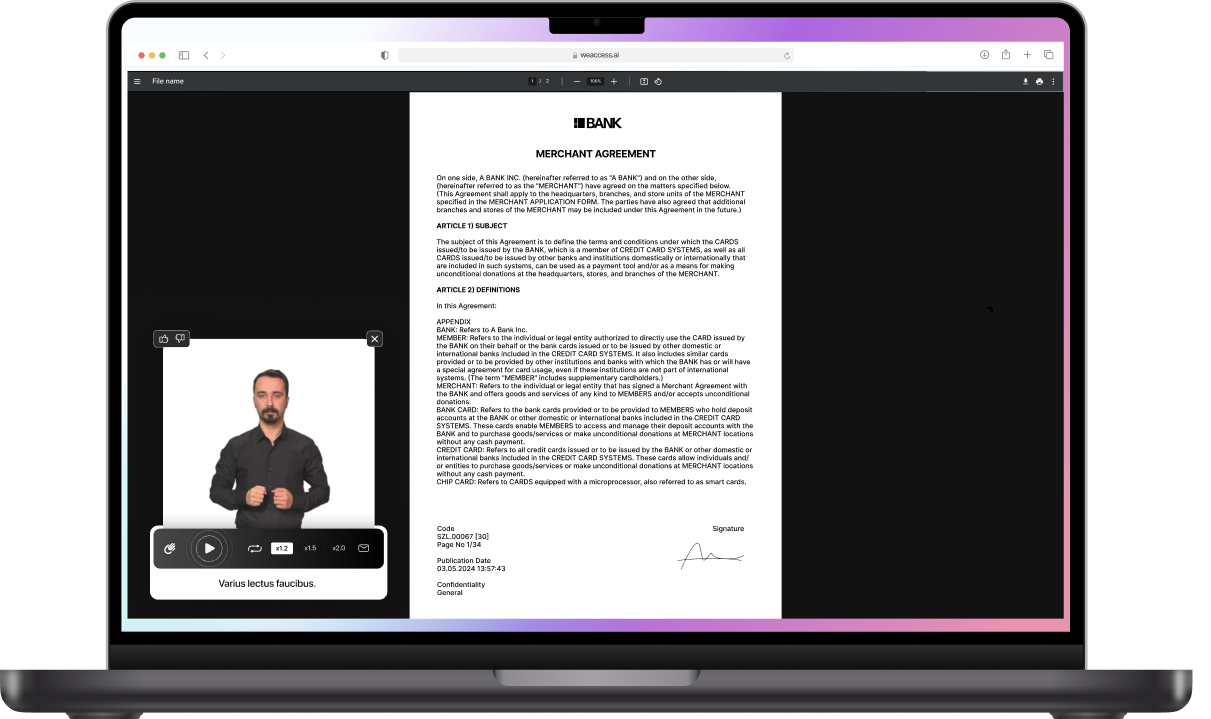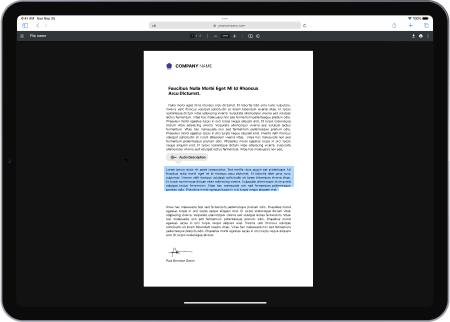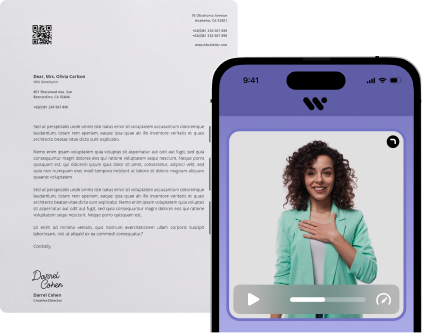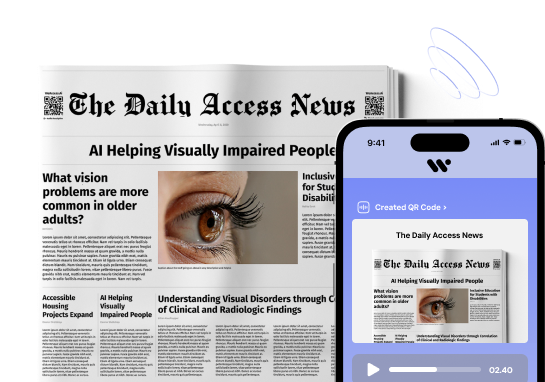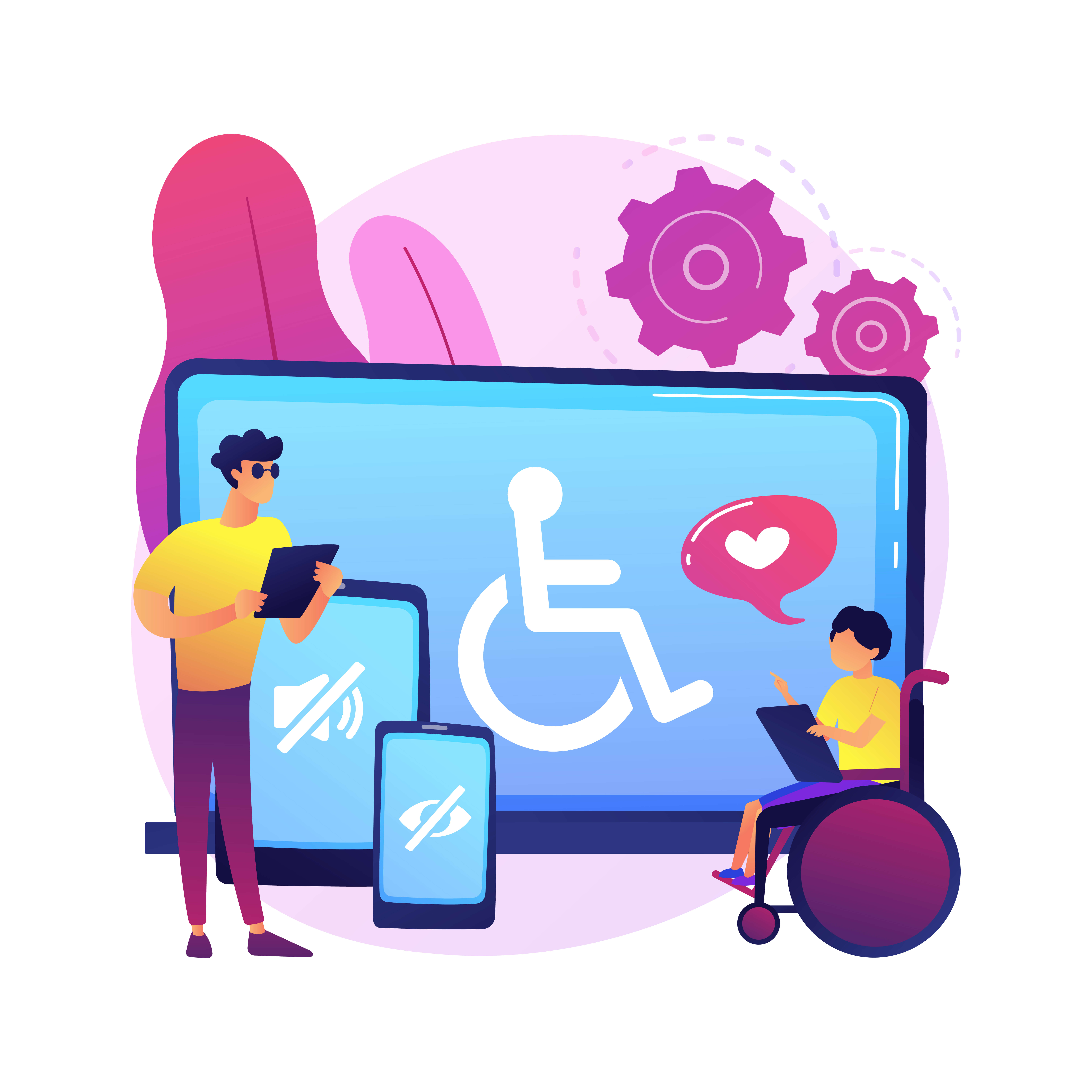The Role of Artificial Intelligence and Assistive Technologies in Digital Accessibility
The Role of Artificial Intelligence and Assistive Technologies in Digital Accessibility
Artificial intelligence technologies continue to be developed today for many reasons, such as the need for a sector-based workforce, the desire to find ways to respond to people's needs more quickly, and many other purposes that we cannot list here. Before the artificial intelligence revolution, there were only robots that could fulfill sequential commands and virtual assistants based on them, but over time, machine learning modules have developed and now artificial intelligence software can learn things on their own.
Today, the ChatGPT tool developed by OpenAI makes life easier for many people. Many artificial intelligence platforms, too many to name, allow many tasks to be done, from creating presentations to editing audio files. So what does artificial intelligence offer us when it comes to the needs of people with disabilities? Are there artificial intelligence software and products to meet the needs of people with disabilities? The answer is of course yes. In our article, we will discuss the role of artificial intelligence and assistive technologies in digital accessibility.
Introduction
We will start by introducing the concept of digital accessibility and briefly discussing the development of artificial intelligence and assistive technologies. In this way, our readers who are reading our articles for the first time and especially those who do not know much about digital accessibility will get to know this topic better. We have also published other articles on what digital accessibility is and its importance, you can check them out on our blog page..
What is digital accessibility?
Web accessibility is a term that describes the appropriate organization of web content for individuals with visual, hearing or other disabilities. When a website provides a screen reader or high contrast for the visually impaired and an easy-to-understand or sign language supported user experience for the hearing impaired, it is possible to say that the website offers an accessible experience Digital accessibility is the ability of all individuals with and without disabilities to access a website, mobile application or any digital item in a comfortable way. For an accessible experience, institutions and organizations carry out various studies according to disability groups. For example, for an individual with low vision, the relevant institution or organization can add high contrast modes and font size settings to their website/mobile applications.
In other words, digital accessibility is the ability of people with visual, hearing or other disabilities, or people without any physical disability, to access digital services with the same ease with the tools they use.
Development of artificial intelligence and assistive technologies?
The widespread use of computers, the proliferation of software development areas and many other factors have made it possible for people to use many useful software programs many years ago. Of course, the emergence of standards has pushed both operating system manufacturers and other third-party developers to develop solutions to meet the needs of different user groups. This process has also led to software solutions for people with disabilities. This is exactly where the development of assistive technologies begins.
Of course, it does not make sense to limit accessibility only to the computer side. The emergence of many hardware-based technologies (e.g. Bluetooth, improved camera optical lenses, etc.) has contributed to the emergence of a variety of products that meet the different needs of disabled consumers. Examples include Braille displays and hardware magnification/high contrast devices for low vision.
Then we heard about artificial intelligence, and suddenly there were many AI-based applications to make people's lives easier. While virtual assistants and automation systems developed before the AI revolution could only process the sequential data given to them, with AI they have become capable of much more. First of all, these software can now learn how to do something from very small sets of information and can analyze in addition to performing an operation.
It is also important to remember that when they are connected to the internet, they can receive data from thousands of digital sources around the world. All of this makes artificial intelligence-based systems widely used today.
The development of artificial intelligence technologies, of course, raises many questions, the most important of which is, will these technologies one day make life easier for people with disabilities? This is the question. Our answer is, why not?
You want AI to recognize something, teach it what it is. Do you want to improve audio files or photos with AI? Show a software you have developed how to do this. Why shouldn't a technology that can do all this make life easier for people with disabilities?
Today, there are some services and applications developed for the needs of people with disabilities that utilize artificial intelligence. In addition to such products, there are also software and hardware developed for the disabled that have been in our lives for a long time. These include screen readers and screen magnification software for the visually impaired, magnification software for the low vision, accessibility software that offers high contrast options and magnification devices that can optically zoom, and hearing aids for the hearing impaired
The importance of digital accessibility
As in every field, companies need to allocate a budget to work on digital accessibility. Institutions and organizations that want to allocate resources to this area will naturally wonder why accessibility is important. In this section, we will take a closer look at the importance of digital accessibility..
The concept and importance of digital accessibility
In short, digital accessibility refers to the application of criteria that enable people with disabilities to access everything offered in the digital world as easily as people without disabilities. It doesn't matter whether it is a website or a mobile application, if it is properly structured for people with visual impairments, hearing impairments or other disabilities, we can say that the platform is "accessible for everyone".
When it comes to the importance of digital accessibility, we should say at the very beginning that it is very important that you work in accordance with accessibility as a requirement of everyone's right to access information. The importance you attach to accessibility will ensure the protection of the right to information for people with disabilities and open the doors to a better digital experience for them.
In addition, as a corporate structure, caring for even the smallest customer group is an important consideration to realize your commercial goals. A visually or hearing impaired person can visit your website at any time, everyone who comes to visit you is a potential customer candidate. Don't you want to meet this potential customer in the most appropriate way?
Services for people with disabilities are an important point of sensitivity for a part of the society. If you give importance to accessibility on your website, mobile application and other platforms and communicate it to the public in the right way, you will attract people's attention. Anyone who sees that you care about people with disabilities will visit you or recommend you to others. This, of course, means more web/mobile traffic and more customers.
Finally, accessibility is also important for reaching more disabled users. People with disabilities share their positive experiences in the various online groups they are members of and contribute to their awareness. In this way, other people in those groups will visit your website and even become potential customers.
Who is digital accessibility important to?
Digital accessibility is of great importance for all people with disabilities around the world who access the internet. Today, the internet and electronic devices are the first place people turn to for information, to buy a product or for various other things, and you are part of this family with your website, mobile application or other elements of the digital world.
Today's accessibility software helps a disabled consumer who wants to shop online with his credit card, a disabled graduate student doing scientific research for his thesis, a disabled reader who likes to follow the agenda and many more. In these and many other scenarios, an accessible platform makes life easier for people with disabilities.
Digital accessibility concerns millions of disabled people around the world. Today, there are many digital platforms that are far from providing an accessible experience, but you can get ahead of dozens of competitors by really paying attention to this issue.
Artificial Intelligence and Assistive Technologies
In this part of our article, we will look at what artificial intelligence is, assistive technologies for people with disabilities and the relationship between artificial intelligence and assistive technologies. We will take a closer look at examples of assistive technology software and examine how AI has or could improve them.
Definition and functioning of artificial intelligence
Artificial intelligence is the name given to machines/software that can perform human tasks, gain experience, adapt to new inputs and perform analysis. Machine learning modules are developed to train artificial intelligence platforms, and various data sets are given to the artificial intelligence to learn what it really needs to do.
Today, institutions and organizations use artificial intelligence-based services in various fields, and these services provide great benefits to institutions in terms of both workforce and time.
Artificial intelligence mimics human intelligence to perform specific tasks. AI products can improve themselves by processing the information they acquire.
AI works by combining large-scale data with intelligent algorithms and iterative processing. In this process, patterns or features of the processed data enable AI to learn automatically. Artificial intelligence with various functions works with different methods and technologies.
Types and uses of assistive technologies
Assistive technologies have different types and different uses for individuals with different disabilities.
Let's start with screen reader software. Today, there are different types of screen-reading software available for mobile devices and computers, both built into operating systems and published by third-party developers. Some of these include options such as magnification and high contrast to cater to users with low vision. In this way, users with low vision who use a computer with screen reader support can simultaneously use other accessibility features they need.
There are also devices and software targeting people with low vision. Today, especially the accessibility solutions developed by Apple meet the needs of computer/smartphone users with low or no vision to a great extent. However, in the Windows operating system, internal features may be insufficient depending on various needs. Various companies have developed and continue to develop software to meet these needs. On the other hand, there are products that meet the different needs of both blind and partially sighted individuals.
Braille displays, for example, allow the visually impaired to read the content displayed on their computers in Braille with the support of a screen reader. Magnification devices with optical lenses allow people with low vision to read books written in the Latin alphabet at any level of zoom and in high contrast mode.
Hearing aids are being developed for hearing impaired individuals. These devices make life easier for people with hearing impairments who can hear with a hearing aid.
Today, software and hardware products are being developed for people with disabilities for many more purposes.
The interrelationship of AI and assistive technologies
The development of artificial intelligence and assistive technologies raises the question: can AI-based technologies contribute to the development of accessibility-oriented software and hardware? What is the relationship between these two concepts today?
Artificial intelligence, when used in the right ways, can of course contribute greatly to the development of assistive technologies, and there are even application features developed for this purpose today.
The Role of AI and Assistive Technologies in Digital Accessibility The role of AI and assistive technologies in digital accessibility is an important topic because in our previous topic, we only discussed traditional accessibility tools such as screen readers and some devices. However, as we mentioned, there are other assistive technology tools that work with the support of AI, and they can really make life easier for people with disabilities. We will discuss them now.
Automatic text recognition and reading software Text recognition software, which we often hear about under the name of optical character recognition (OCR), is very important today as it is used not only by visually impaired individuals but also by people who want to quickly convert a physical document into a digital text.
In the past, OCRing a document or a book was only possible with specialized machines, which were not very suitable for individual use and were only available in a limited number of libraries for the visually impaired. The main problem was not so much the OCR process, but the digitization of a book, which could also be done on a computer with various software.
But the increasing development of smartphone cameras has made it easier for visually impaired people to meet these needs. At first, applications that could perform character recognition in a limited way started to enrich with artificial intelligence features over time.
In this way, reading a page of a book has become much easier for a blind person. In addition, over time, these software also gained text reading features.
In this way, a photographed document was recognized more accurately with the help of artificial intelligence and could be listened to with a single button independent of the screen reader software.
Providing voice commands and responses
Another important thing that AI has brought to the digital world is virtual assistants and voice command systems. Like text recognition technologies, voice assistants did not directly target disabled users, but they made their lives much easier.
For example, normally, a visually impaired iPhone user who wanted to use their smartphone to search for a person in their contacts list would first have to open the Contacts app and select the person they wanted to call. This can be time-consuming, especially for people who are not familiar with screen reader shortcuts. However, using Siri to say the name of the person they wanted to call and giving the "call" command prevented this waste of time because Siri was able to perform this process in a very short time.
Virtual assistants like Siri continue to touch everyone's lives, as they allow for many more operations. On top of that, these services are getting smarter and smarter every day.
Over time, voice assistants have been incorporated into screen readers in much simpler ways. For example, in Google TalkBack, you can use the action menu to give short commands to the assistant about how you want to read an item.
The importance of image recognition technologies
Today, applications for the visually impaired based on image recognition technologies are becoming increasingly popular. In image processing technologies, developers can use existing trained artificial intelligence modules or they can create and train their own artificial intelligence modules. However, the latter option would require a lot of effort and cost.
Today, Open AI's GPT4 AI has been trained with millions of data and images, and we can already see visual recognition applications using GPT4 in the market. In addition, other AI modules trained for various purposes are also available.
Image processing technologies are crucial for both getting detailed information about a photograph and learning the textual elements in an image. Many AI-supported image recognition applications developed today touch the lives of visually impaired individuals and make their lives easier in many areas from education to daily work.
Screen reading software and speech recognition systems Screen reading software is an important component that makes life easier for visually impaired electronic device users. This software reads aloud to the user the items displayed on the device screen, whether it is a computer, phone or smartwatch. Text-to-speech software is also needed to enable the software to voice the items on the screen.
Some screen readers may include a built-in voice engine, and mobile operating systems often have a pre-installed text-to-speech engine and synthesizer that, when the screen reader is activated, starts running and voices the items.
With the support of artificial intelligence, text-to-speech software is now able to read more naturally and vocalize items the way they should be. In the past, users were greeted with more robotic voices and mispronunciations. But with advances in technology and artificial intelligence, the quality has improved considerably. Of course, there are some voice engines that don't take advantage of this.
The Future of Artificial Intelligence and Assistive Technologies in Digital Accessibility
As in the moment we live in, artificial intelligence will continue to meet us with solutions that will respond to the accessibility needs of disabled individuals in the future. This is a harbinger of a good future in the field of artificial intelligence and assistive technologies. And why?
The potential of AI and assistive technologies Artificial intelligence, which develops every day and constantly surprises us with different surprises, is a tool with high potential when used correctly, even though it harbors various risks. Can you imagine the power that will emerge when you combine artificial intelligence, which has unlimited potential, with some assistive technology tools that currently have limited potential? If not, don't worry, because this topic is endless.
The screen readers, text recognition applications, visual description tools and much more will continue to develop day by day with the right moves and will continue to make our lives much easier.
Future developments and prospects
AI products will find their way into many more people's homes and pockets in the future, and their proliferation will certainly contribute to a more inclusive world.
Screen reader software will become smarter, and perhaps people will be able to get a better device experience than today with easy control shortcuts.
Visual recognition technologies will advance, perhaps even guiding the visually impaired to find lost items. Hearing aids will be smarter and will change shape depending on need, making life much easier.
For a screen reader that meets your every need today, you might think, "what's the maximum feature that can be added to it?", but remember, ideas always come when an entrepreneur comes up with something that no one else has thought of. That idea is powered by AI, and it contributes to a better digital experience in the future.
Keep your expectations positive about the development of AI and assistive technologies. Believe me, great things will happen and it will make life easier for both users and organizations. For example, providing an accessible experience for your disabled visitors with one click?
Challenges and Solutions
Businesses that decide to implement digital accessibility can face a variety of challenges. At WeAccess.Ai, we have developed our AI solutions to help you solve these problems. But first, let's get to know the common problems, then talk about the solutions and the services WeAccess.Ai offers.
Problems that businesses face in the digital accessibility process Businesses that have no knowledge about the subject do not know where to start in the digital accessibility process. For example, websites have different stages of the digital accessibility process, and for these, companies need to work with expert software developers, graphic designers and people with disabilities. Software developers and design teams should know the digital needs of people with disabilities, and if they do not know enough about this issue, they can request support from people with disabilities.
The second major challenge that companies may face in the digital accessibility process is the process of conducting appropriate studies and internal testing. At this stage, the needs of individuals with visual, hearing and other disabilities on websites, mobile applications or devices and the deficiencies in these services are analyzed. The accessibility problems found should be solved by a team with knowledge of the subject.
The last challenge for institutions and organizations is to understand whether the work is actually working. For this, companies should enable disabled users themselves to test the relevant digital content or physical device. A visually impaired person who will use the developed product, website or mobile application can identify possible shortcomings that have been overlooked and report them to the company, and other shortcomings will be addressed in the light of this feedback.
Recommendations for better digital accessibility
For better digital accessibility, it is important for companies to include professional developers and web designers on their teams. Most good developers know how to make an application accessible or know the resources to access this information.
In accessibility processes, it is the golden key to a better experience for companies to get feedback from people with disabilities who will use that digital platform. Feedback from a disabled user who knows technology well will take your brand 1 step further for perfect accessibility.
We also have a bonus tip for you, you can easily provide your visitors with an accessible experience for your websites and YouTube videos by using the artificial intelligence-based services we have developed at WeAccess.Ai. At WeAccess.Ai, we offer Thanks to the WeAnalyse tool, you can report accessibility issues on your website with a single click, By integrating our WeTool tool into your website, you can ensure that these AI-detected issues are easily resolved and can automatically resolve any accessibility issues that may arise in the future,
With our WePhoto tool, you can add alternative texts to the images on your website and create alternative texts for your social media posts, Our WeVideo tool allows you to create audio descriptions for your videos, With our WeSign tool, you can provide accessible text for hearing impaired people on your websites.
Conclusion
In this article, we talked about artificial intelligence and assistive technologies, briefly discussed AI-supported digital services and got to know assistive technologies closely. We briefly evaluated the relationship between artificial intelligence and assistive technologies and briefly evaluated what kind of services can be developed for people with disabilities with artificial intelligence. We took a look at the difficulties that businesses may experience in the process of implementing digital accessibility and got to know both what companies need to do for better digital accessibility and WeAccess.Ai services closely.
Today, various software and hardware such as screen readers, Braille displays and hearing aids continue to make the lives of people with disabilities easier and are entering the lives of more and more people every day. When the capabilities offered by AI technologies and the power of these technologies come together, we should look forward to seeing truly amazing things. We hope to see more and more accessibility-focused solutions based on AI, and that the digital world becomes a place where people with disabilities can navigate freely.
You may be interested : Accessibility Design Process

